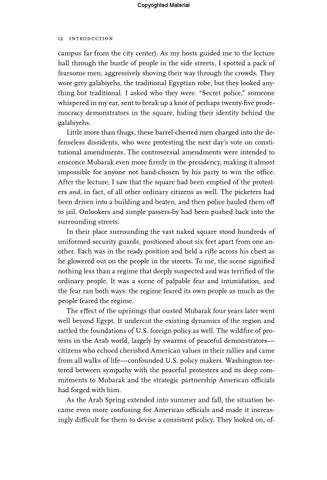Copyrighted Material
12 introduction
campus far from the city center). As my hosts guided me to the lecture hall through the bustle of people in the side streets, I spotted a pack of fearsome men, aggressively shoving their way through the crowds. They wore grey galabiyehs, the traditional Egyptian robe, but they looked anything but traditional. I asked who they were. “Secret police,” someone whispered in my ear, sent to break up a knot of perhaps twenty-five prodemocracy demonstrators in the square, hiding their identity behind the galabiyehs. Little more than thugs, these barrel-chested men charged into the defenseless dissidents, who were protesting the next day’s vote on constitutional amendments. The controversial amendments were intended to ensconce Mubarak even more firmly in the presidency, making it almost impossible for anyone not hand-chosen by his party to win the office. After the lecture, I saw that the square had been emptied of the protesters and, in fact, of all other ordinary citizens as well. The picketers had been driven into a building and beaten, and then police hauled them off to jail. Onlookers and simple passers-by had been pushed back into the surrounding streets. In their place surrounding the vast naked square stood hundreds of uniformed security guards, positioned about six feet apart from one another. Each was in the ready position and held a rifle across his chest as he glowered out on the people in the streets. To me, the scene signified nothing less than a regime that deeply suspected and was terrified of the ordinary people. It was a scene of palpable fear and intimidation, and the fear ran both ways: the regime feared its own people as much as the people feared the regime. The effect of the uprisings that ousted Mubarak four years later went well beyond Egypt. It undercut the existing dynamics of the region and rattled the foundations of U.S. foreign policy as well. The wildfire of protests in the Arab world, largely by swarms of peaceful demonstrators— citizens who echoed cherished American values in their rallies and came from all walks of life—confounded U.S. policy makers. Washington teetered between sympathy with the peaceful protesters and its deep commitments to Mubarak and the strategic partnership American officials had forged with him. As the Arab Spring extended into summer and fall, the situation became even more confusing for American officials and made it increasingly difficult for them to devise a consistent policy. They looked on, of-
C6337.indb 12
1/8/14 1:32 PM
